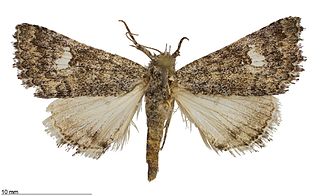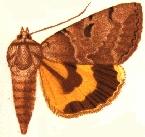
The Noctuidae, commonly known as owlet moths, cutworms or armyworms, are a family of moths. They are considered the most controversial family in the superfamily Noctuoidea because many of the clades are constantly changing, along with the other families of the Noctuoidea. It was considered the largest family in Lepidoptera for a long time, but after regrouping Lymantriinae, Catocalinae and Calpinae within the family Erebidae, the latter holds this title now. Currently, Noctuidae is the second largest family in Noctuoidea, with about 1,089 genera and 11,772 species. This classification is still contingent, as more changes continue to appear between Noctuidae and Erebidae.

Utetheisa is a genus of tiger moths in the family Erebidae. The genus was first described by Jacob Hübner in 1819.

Gracillariidae is an important family of insects in the order Lepidoptera and the principal family of leaf miners that includes several economic, horticultural or recently invasive pest species such as the horse-chestnut leaf miner, Cameraria ohridella.

Cyana is a genus of moths in the family Erebidae. Species are well distributed in Africa, Madagascar, China, India, Sri Lanka, Myanmar, Sumatra, Java and Borneo. The genus was erected by Francis Walker in 1854.

Gnophaela is a genus of tiger moths in the family Erebidae. The genus was erected by Francis Walker in 1854.

Peridroma saucia, the pearly underwing or variegated cutworm, is a moth of the family Noctuidae. The species was first described by Jacob Hübner in 1808. It is found in North and South America, Europe, Asia and Africa. The variegated cutworm feeds on many plants, especially common fruits and vegetables. The moth undergoes two to four generations per year. The development of the moth slows in colder temperatures, indicative of its migratory nature. All stages of the life cycle have a developmental threshold for temperature. The moth is known to migrate to the northern regions during warmer months, returning to the southern regions when the climate becomes colder.

Lerina is a monotypic moth genus in the family Erebidae. Its only species, Lerina incarnata, the crimson-bodied lichen moth, is found in Mexico and southern Arizona. Both the genus and species were first described by Francis Walker in 1854.

Lyclene is a genus of lichen moths of the family Erebidae, subfamily Arctiinae. The genus was erected by Frederic Moore in 1860.
Sermyla is a monotypic moth genus in the subfamily Arctiinae. Its only species, Sermyla transversa, is found in Brazil. Both the genus and species were first described by Francis Walker in 1854.

Chytolita is a monotypic litter moth genus of the family Erebidae erected by Augustus Radcliffe Grote in 1873. Its only species, Chytolita morbidalis, the morbid owlet moth or morbid owlet, was first described by Achille Guenée in 1854. It is found in large parts of North America, from coast to coast in the north and south to North Carolina, Texas and Florida in the west. The habitat consists of deciduous woods and edges.

Zanclognatha is a genus of litter moths of the family Erebidae. The genus was erected by Julius Lederer in 1857.

Heteranassa is a monotypic moth genus in the family Erebidae described by J. B. Smith in 1899. Its only species, Heteranassa mima, was first described by Leon F. Harvey in 1876. It is found in warm, arid habitats in North America from California to Texas, northward to Oklahoma, and south as far as Oaxaca in Mexico.

Eudocima materna, the dot-underwing moth, is a moth of the family Erebidae found in widespread parts of the world, mainly in tropical Asia extending to New Guinea and Australia as well as in Africa. Reports from the United States, Canada and the French Antilles are now considered to be Eudocima apta. The species can be differentiated from other Eudocima moths by the presence of small central black dot in each hindwing. The species was first described by Carl Linnaeus in his 1767 12th edition of Systema Naturae.

Catocala illecta, the Magdalen underwing, is a moth of the family Erebidae. The species was first described by Francis Walker in 1858. It is found in North America from south-western Ontario south to Tennessee and South Carolina and west and south to Texas and north through Oklahoma and Kansas to Nebraska, Wisconsin, Indiana, Illinois and Michigan.

Catocala nuptialis, the married underwing, is a moth of the family Erebidae. The species was first described by Francis Walker in 1858. It is found in North America from Manitoba south through Minnesota and Nebraska to eastern Oklahoma and Texas and east to Kentucky and Illinois.

Synemon is a genus of moths within the family Castniidae. It was described by Edward Doubleday in 1846. The genus contains 24 described and 20 undescribed species. These species are found across mainland Australia and on Kangaroo Island, with the highest diversity in Western Australia. Synemon species can be found in a range of habitats, including woodlands, heathlands and native perennial grasslands. The adults fly during the daytime in warm to hot weather. They have clubbed antennae, and are often mistaken for butterflies.

Eupithecia zygadeniata is a species of moth in the family Geometridae. It was first described by Alpheus Spring Packard in 1876 and is found in North America, with records from Texas and Montana.
Dysschema subapicalis is a moth of the family Erebidae first described by Francis Walker in 1854. It is restricted to the Atlantic forests of south-eastern Brazil.

Macrobrochis gigas is a moth of the family Erebidae. It was described by Francis Walker in 1854. It is found in China (Yunnan), India (Sikkim), Bhutan, Nepal, Indonesia, Hong Kong and Taiwan. The habitat consists of woodlands.
Cheverella is a monotypic genus of snout moths in the subfamily Spilomelinae of the family Crambidae. It contains only one species, Cheverella galapagensis, which is endemic to the Galápagos Islands of Ecuador. Both the genus and the species were first described by Bernard Landry in 2011. The genus is placed in the tribe Udeini.















